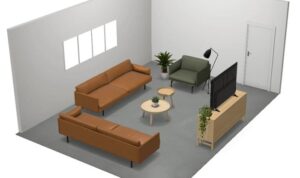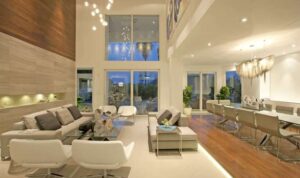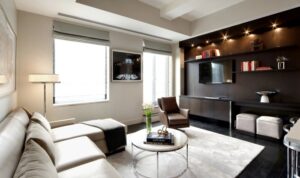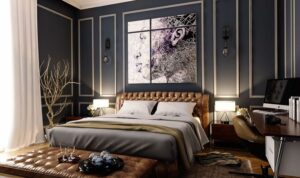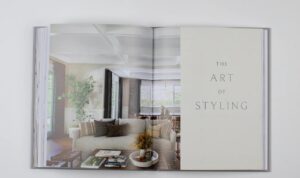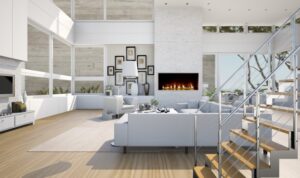Embark on a journey through the realm of home interior design, where creativity meets functionality to shape living spaces. From color palettes to furniture arrangements, every detail plays a vital role in creating a harmonious environment that reflects personal style and enhances well-being.
Importance of Home Interior Design
Home interior design plays a crucial role in shaping our overall well-being by creating spaces that are not only functional but also visually appealing and personalized to our tastes.
Enhancing Functionality and Aesthetics
- Efficient space utilization through smart furniture placement and storage solutions can make a small room feel larger and more organized.
- The use of appropriate lighting fixtures can create different moods and enhance the ambiance of a room.
- Choosing colors, textures, and patterns that complement each other can create a cohesive and harmonious look throughout the home.
Reflecting Personal Style and Preferences
- Decor elements such as artwork, accessories, and furniture pieces can reflect the homeowner's personality and interests.
- Customization options in interior design allow individuals to create spaces that resonate with their unique style and preferences.
- Personalized touches such as family photos, heirlooms, or souvenirs can add a sense of nostalgia and warmth to the home.
Elements of Home Interior Design
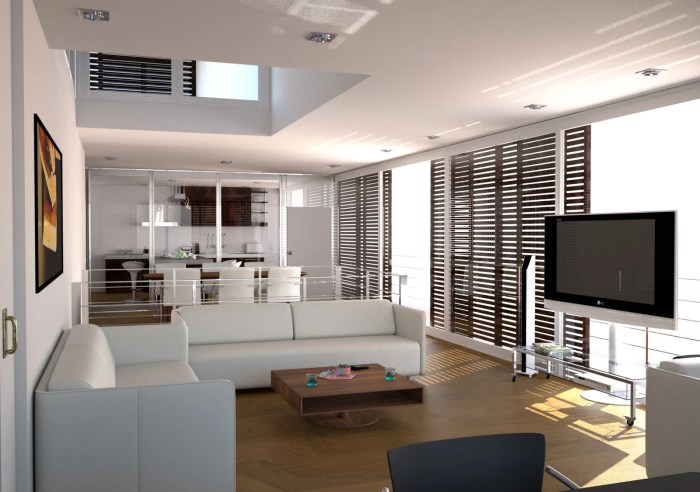
When it comes to home interior design, there are several key elements that play a crucial role in creating a cohesive and visually appealing space. These elements include color schemes, furniture selection, lighting, and accessories, all of which work together to define the style and mood of a room.
Color Schemes
Color schemes are essential in setting the tone for a room. They can influence the mood and atmosphere of a space, with different colors evoking different emotions. Whether you opt for a monochromatic palette, complementary colors, or contrasting shades, the choice of colors can make a significant impact on the overall design.
Furniture Selection
The furniture you choose can make or break a room's design. From the style and material to the placement and size, each piece of furniture contributes to the overall aesthetic. Whether you prefer modern, minimalist, traditional, or eclectic furniture styles, selecting pieces that complement each other is key to creating a cohesive look.
Lighting
Lighting is a crucial element in interior design as it can affect the ambiance, functionality, and aesthetics of a space. Whether you opt for natural light, overhead fixtures, or accent lighting, the right lighting can highlight key features, create focal points, and enhance the overall design of a room.
Accessories
Accessories such as rugs, curtains, artwork, and decorative items add the finishing touches to a room. They can inject personality, texture, and visual interest into a space. By carefully selecting and arranging accessories, you can elevate the design and create a space that reflects your personal style.
Space Planning and Layout
Space planning is a crucial aspect of home interior design that involves optimizing room layouts to ensure functionality and flow. By carefully planning how furniture and decor are arranged in a space, you can create a harmonious and balanced environment that maximizes both aesthetics and usability.
Tips for Arranging Furniture
- Consider the function of the room and arrange furniture accordingly. For example, in a living room, the seating area should be conducive to conversation and entertainment.
- Allow for adequate space between furniture pieces to ensure easy movement and accessibility.
- Create a focal point in each room, such as a fireplace, artwork, or statement piece of furniture, to draw the eye and anchor the space.
- Use rugs, lighting, and accessories to define different areas within a room and create visual interest.
Importance of Creating Focal Points
Creating focal points in different rooms is essential for adding visual interest and guiding the eye through the space. Focal points can help balance the overall design and draw attention to key elements within a room. Whether it's a striking piece of artwork, a beautiful view, or a unique architectural feature, focal points play a crucial role in enhancing the aesthetics of a space.
Lighting Design
Lighting plays a crucial role in interior design as it can greatly impact the mood, functionality, and aesthetics of a space. Proper lighting design can enhance the overall look of a room, highlight key features, and create different atmospheres depending on the type of lighting used.
Types of Lighting Techniques
- Ambient Lighting: This type of lighting provides overall illumination to a room and sets the tone for the space. It can be achieved through ceiling-mounted fixtures, wall sconces, or chandeliers.
- Task Lighting: Task lighting is focused on specific areas where activities like reading, cooking, or working take place. It includes desk lamps, under-cabinet lighting, and pendant lights.
- Accent Lighting: Accent lighting is used to highlight architectural features, artwork, or other focal points in a room. It can be achieved with track lighting, wall washers, or picture lights.
Incorporating Natural and Artificial Light Sources
Effective lighting design incorporates both natural and artificial light sources. Natural light can be maximized by using large windows, skylights, or light-colored walls that reflect light. To balance natural light, artificial light sources like pendant lights, floor lamps, and recessed lighting can be strategically placed to fill in darker areas or provide additional illumination in the evenings.
Color Theory and Application
Color plays a crucial role in interior design, impacting not only the aesthetics but also the mood and perception of a space. By understanding the psychology of colors, you can strategically choose palettes to create the desired atmosphere in each room.
Psychology of Colors
- Colors like blue and green are known for their calming effects, making them perfect for bedrooms or relaxation areas.
- Warm tones like red and yellow can stimulate energy and creativity, ideal for spaces like home offices or dining rooms.
- Neutral colors such as white, beige, or gray can create a sense of balance and sophistication, suitable for living rooms or hallways.
Selecting Color Palettes
- Consider the function of the room - for example, vibrant hues might be more suitable for a playroom or exercise area.
- Use the color wheel to create harmonious combinations, such as complementary colors or analogous schemes.
- Experiment with different shades and tones to add depth and visual interest to the space.
Creating Visual Interest and Harmony
- Balance bold and neutral colors to avoid overwhelming the eye and maintain a cohesive look.
- Introduce accent colors through accessories or furniture pieces to add pops of color without dominating the space.
- Use color to highlight architectural features or create focal points within a room.
Furniture Selection and Placement
When it comes to home interior design, furniture selection and placement play a crucial role in creating a functional and aesthetically pleasing space. Choosing the right furniture pieces for different rooms can enhance the overall look and feel of your home.
Choosing the Right Furniture Pieces
- Consider the size of the room and the scale of the furniture to ensure a proper fit.
- Think about the function of the room and choose furniture that serves that purpose.
- Pay attention to the style and materials of the furniture to create a cohesive look with the rest of the space.
Importance of Scale, Proportion, and Balance
- Scale refers to the size of the furniture in relation to the room size, while proportion deals with the relationship between different pieces of furniture.
- Balance is important to distribute visual weight evenly in the room, ensuring a harmonious and comfortable space.
- By considering scale, proportion, and balance, you can create a well-balanced and visually appealing furniture arrangement.
Mixing and Matching Furniture Styles
- Experiment with mixing different furniture styles to add depth and character to your space.
- Combine modern and traditional pieces for a unique and eclectic look.
- Use a common color palette or material to tie together different furniture styles for a cohesive design.
Decor and Accessories
When it comes to interior design, decor elements and accessories play a crucial role in adding personality and charm to a space. They can enhance the overall look and feel of a room, creating a cohesive and inviting atmosphere.
Artwork, Rugs, and Plants
Decor elements such as artwork, rugs, and plants can bring life to a room. Artwork adds a pop of color and visual interest, while rugs can define a space and add warmth. Plants not only freshen up the air but also add a touch of nature to the indoors.
Accessorizing Tips
- Choose items that reflect your personality and style to make the space feel uniquely yours.
- Mix and match textures, colors, and patterns to create visual interest.
- Don't overcrowd the space with accessories; instead, focus on a few statement pieces.
- Use accessories to highlight the focal points of the room and draw the eye to specific areas.
Styling Shelves, Mantels, and Coffee Tables
When styling shelves, mantels, and coffee tables, consider the following:
- Play with different heights and shapes to create a dynamic display.
- Group items in odd numbers for a visually pleasing arrangement.
- Mix decorative objects with functional items for a balanced look.
- Create layers by placing items in front and behind each other for depth.
Closure
As we conclude our exploration of home interior design, remember that each element - from lighting to decor - contributes to the tapestry of your home. Let your imagination run wild as you transform spaces into personalized sanctuaries that breathe life and character.
FAQ Overview
How does interior design impact well-being?
Interior design influences mood and productivity, creating spaces that promote relaxation or boost energy levels.
What are some key elements of interior design?
Color schemes, furniture selection, lighting, and accessories are essential components that shape the overall design.
How can I optimize room layouts through space planning?
Space planning involves strategically arranging furniture to maximize functionality and flow within a space.
Why is lighting design important in interior design?
Lighting sets the ambiance and highlights key features of a room, enhancing its overall appeal.
What role do decor and accessories play in interior design?
Decor elements such as artwork, rugs, and plants add personality and charm, elevating the visual interest of a space.

